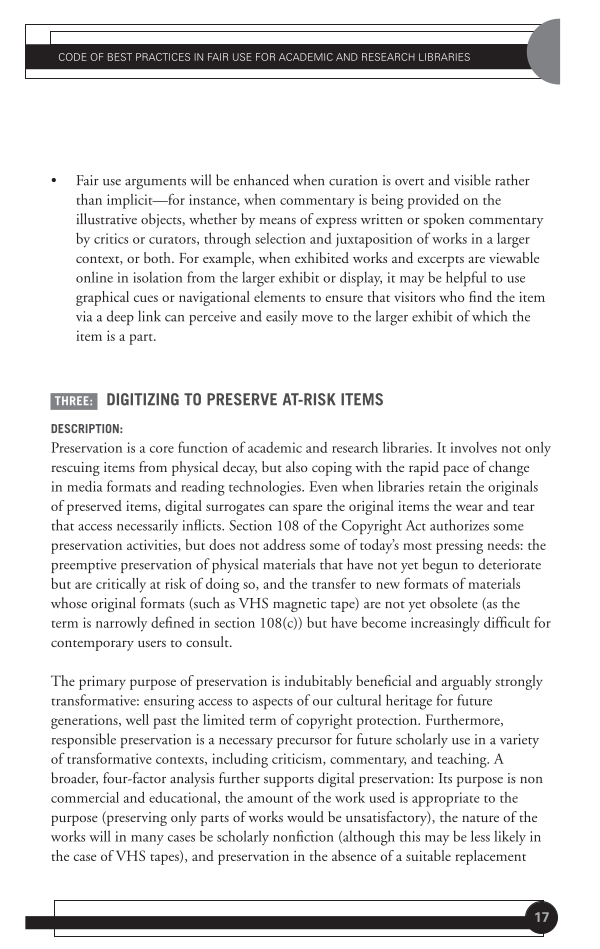CODE OF BEST PRACTICES IN FAIR USE FOR ACADEMIC AND RESEARCH LIBRARIES
17
• Fair use arguments will be enhanced when curation is overt and visible rather
than implicit—for instance, when commentary is being provided on the
illustrative objects, whether by means of express written or spoken commentary
by critics or curators, through selection and juxtaposition of works in a larger
context, or both. For example, when exhibited works and excerpts are viewable
online in isolation from the larger exhibit or display, it may be helpful to use
graphical cues or navigational elements to ensure that visitors who find the item
via a deep link can perceive and easily move to the larger exhibit of which the
item is a part.
THREE: DIGITIZING TO PRESERVE AT-RISK ITEMS
DESCRIPTION:
Preservation is a core function of academic and research libraries. It involves not only
rescuing items from physical decay, but also coping with the rapid pace of change
in media formats and reading technologies. Even when libraries retain the originals
of preserved items, digital surrogates can spare the original items the wear and tear
that access necessarily inflicts. Section 108 of the Copyright Act authorizes some
preservation activities, but does not address some of today’s most pressing needs: the
preemptive preservation of physical materials that have not yet begun to deteriorate
but are critically at risk of doing so, and the transfer to new formats of materials
whose original formats (such as VHS magnetic tape) are not yet obsolete (as the
term is narrowly defined in section 108(c)) but have become increasingly difficult for
contemporary users to consult.
The primary purpose of preservation is indubitably beneficial and arguably strongly
transformative: ensuring access to aspects of our cultural heritage for future
generations, well past the limited term of copyright protection. Furthermore,
responsible preservation is a necessary precursor for future scholarly use in a variety
of transformative contexts, including criticism, commentary, and teaching. A
broader, four-factor analysis further supports digital preservation: Its purpose is non
commercial and educational, the amount of the work used is appropriate to the
purpose (preserving only parts of works would be unsatisfactory), the nature of the
works will in many cases be scholarly nonfiction (although this may be less likely in
the case of VHS tapes), and preservation in the absence of a suitable replacement
17
• Fair use arguments will be enhanced when curation is overt and visible rather
than implicit—for instance, when commentary is being provided on the
illustrative objects, whether by means of express written or spoken commentary
by critics or curators, through selection and juxtaposition of works in a larger
context, or both. For example, when exhibited works and excerpts are viewable
online in isolation from the larger exhibit or display, it may be helpful to use
graphical cues or navigational elements to ensure that visitors who find the item
via a deep link can perceive and easily move to the larger exhibit of which the
item is a part.
THREE: DIGITIZING TO PRESERVE AT-RISK ITEMS
DESCRIPTION:
Preservation is a core function of academic and research libraries. It involves not only
rescuing items from physical decay, but also coping with the rapid pace of change
in media formats and reading technologies. Even when libraries retain the originals
of preserved items, digital surrogates can spare the original items the wear and tear
that access necessarily inflicts. Section 108 of the Copyright Act authorizes some
preservation activities, but does not address some of today’s most pressing needs: the
preemptive preservation of physical materials that have not yet begun to deteriorate
but are critically at risk of doing so, and the transfer to new formats of materials
whose original formats (such as VHS magnetic tape) are not yet obsolete (as the
term is narrowly defined in section 108(c)) but have become increasingly difficult for
contemporary users to consult.
The primary purpose of preservation is indubitably beneficial and arguably strongly
transformative: ensuring access to aspects of our cultural heritage for future
generations, well past the limited term of copyright protection. Furthermore,
responsible preservation is a necessary precursor for future scholarly use in a variety
of transformative contexts, including criticism, commentary, and teaching. A
broader, four-factor analysis further supports digital preservation: Its purpose is non
commercial and educational, the amount of the work used is appropriate to the
purpose (preserving only parts of works would be unsatisfactory), the nature of the
works will in many cases be scholarly nonfiction (although this may be less likely in
the case of VHS tapes), and preservation in the absence of a suitable replacement


































